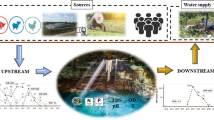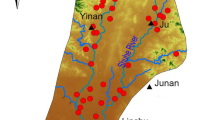Abstract
Sewage effluent was discharged through leaking sewer into the agricultural training farms, University of Ibadan which is used for cultivation of vegetables and cereals, thus constituting threat to human health. This study examined the reliability of the electrical resistivity technique in delineating sewage polluted zones and possible pathways into the groundwater network. The area investigated is underlain by banded gneisses. Ten resistivity Wenner-imaging lines (N-S) were established and inverted section generated using RES2DINV. Thirty VES stations were occupied using Schlumberger array, the current electrode spacing (AB/2) expanded from 1 to 75 m and data analysed using WinResist. 2-D inverted section depicted the top soil and clay unit. Resistivity in the top soil (36–70 Ω-m) showed a decrease of 57 to 78% while the clayey unit (6–18 Ω-m) showed a reduction of 63 to 88% relative to the control units. Plunge in resistivity within the top soil and clay units suggests the presence of pollutants. VES-derived geoelectric section recorded three varying sequences, with a fall in resistivity in the top soil (22–58 Ω-m) and the clay unit (6–15 Ω-m) compared with the reference layers having 233 and 34 Ω-m, respectively; the fractured sections in some parts of the bedrock could serve as a conduit for the seepage of the pollutants into the groundwater system. Drop in resistivity suggests the presence of pollutants within the top soil and clay units. These techniques have helped in mapping out unnatural zones around the farm.












Similar content being viewed by others
Notes
Integrated geophysical and hydrogeological investigation of valley bottom soil in University of Ibadan, southwestern Nigeria. Unpubl. PhD thesis
References
Abdullahi, N. K., Osazuwa, I. B., & Sule, P. O. (2011). Application of integrated geophysical techniques in the investigation of groundwater contamination: a case study of municipal solid waste leachate. Ozean. Journal of Applied Sciences, 4(1), 7–25.
Abdullahi, N. K., Osazuwa, I. B., Sule, P. O., & Onugba, A. (2013). Geophysical assessment of an active open dumpsite in basement complex of northwestern Nigeria. International Journal of Engineering Science Invention, 5, 12–21.
Adepelumi, A. A., Ako, B. D., & Ajayi, T. R. (2001). Groundwater contamination in the basement complex area of Ile-Ife, southwestern Nigeria: a case study using the electrical resistivity geophysical method. Hydrogeology Journal, 9, 611–622.
Al-Tarazi, E., Rajab, J. A., Al-Naqa, A., & El-Waheidi, M. (2008). Detecting leachate plume and groundwater pollution at Ruseifa municipal landfill utilizing VLF-EM method. Journal of Applied Geophysics, 65(3-4), 121–131. https://doi.org/10.1016/j.jappgeo.2008.06.005.
Amidu, S. A., & Olayinka, A. I. (2006). Environmental assessment of sewage disposal systems using 2D electrical-resistivity imaging and geochemical analysis: a case study from Ibadan, southwestern Nigeria. Environmental and Engineering Geoscience, 12(3), 261–272. https://doi.org/10.2113/gseegeosci.12.3.261.
Archie, G. I. (1942). The electrical resistivity log as an aid in determining some reservoir characteristics. Transactions American Institute Mining Metallurgical Engineering, 146, 54–62.
Benson, A. K., Payne, K. L., & Stubben, M. A. (1997). Mapping groundwater contamination using d c resistivity and VLF geophysical methods: a case study. Geophysics, 62(1), 80–96. https://doi.org/10.1190/1.1444148.
Cardarelli, E., & Bernabini, M. (1997). Two case studies of the determination of parameters of urban waste dumps. Journal of Applied Geophysics, 36(4), 167–174. https://doi.org/10.1016/S0926-9851(96)00056-0.
Koda, E., Tkaczyk, A., Lech, M., & Piotr, O.’n. (2017). Application of electrical resistivity data sets for the evaluation of the pollution concentration level within landfill subsoil. Applied Sciences, 7(3), 262. https://doi.org/10.3390/app7030262.
Fatbardha, V., Fatbardha, C., & Piro, L. (2010). Geochemical-geophysical studies tecnogen pollution in Porto Romano, Albania and their integration in GIS. J. Int. Environmental Application & Science, 5(2), 264–271.
Ganiyu, S. A., Badmus, B. S., Oladunjoye, M. A., Aizebeokhai, A. P., Ozebo, V. C., Idowu, O. A., & Olurin, O. T. (2016). Assessment of groundwater contamination around active dumpsite in Ibadan southwestern Nigeria using integrated electrical resistivity and hydrochemical methods. Environ Earth Sci, 75, 643.
Godio, A., & Naldi, M. (2003). Two-dimensional electrical imaging for detection of hydrocarbon contaminants. Near Surface Geophysics, 1, 131–137.
Kaya, M. A., Özürlan, G., & Şengül, E. (2007). Delineation of soil and groundwater contamination using geophysical methods at a waste disposal site Çanakkale,l Turkey. Environmental Monitoring and Assessment, 135(1-3), 441–446. https://doi.org/10.1007/s10661-007-9662-x.
Kelly, W. E., Bogardi, I., Woldt, W. and Bardossy, A., (1989). Combining surface geoelectrics and borehole measurements for contamination control, ground water management, quantity and quality. Sahuquillo, A., Andreu, J. And O’Donnell, T. (eds). Proceedings of Conference Benidorm, Spain IAHS Publ. no.188, 143–152.
Konstantaki, L. A., Ghos, R., Draganov, D., Diaferia, G., & Heimovaara, T. (2015). Characterization of a heterogeneous landfill using seismic and electrical resistivity data. Geophysics, 80(1), EN13–EN25. https://doi.org/10.1190/geo2014-0263.1.
Loke M.H. (2000). Electrical imaging surveys for environmental and engineering studies: a practical guide to 2-D and 3-D surveys. http://www.geo.mtu.edu/~ctyoung/LOKENOTE.PDF. Accessed 8 June 2015.
Mazac, O., Kelly, W. E., & Landa, I. (1987). Surface geoelectrics for ground-water pollution and protection studies. Journal of Hydrology, 93(3-4), 277–294. https://doi.org/10.1016/0022-1694(87)90100-4.
Ogungbe, A. S., Onori, E. O., & Olaoye, M. (2012). Application of electrical resistivity techniques in the investigation of groundwater contamination: a case study of Ile—Epo Dumpsite, Lagos. International Journal of Geomatics and Geosciences, 3(1), 30–40.
Oladunjoye, M. A., Olayinka, A. I., & Amidu, S. A. (2011). Geoelectrical imaging at an abandoned waste dump site in Ibadan, southwestern Nigeria. Journal of Applied Sciences, 11(22), 3755–3764. https://doi.org/10.3923/jas.2011.3755.3764.
Olaojo, A. A., Oladunjoye, M. A., & Sanuade, O. A. (2016). Geochemical assessment of groundwater pollution from sewage effluents in the university campus of Ibadan, southwestern Nigeria. Journal of the Geological Society of India, 88(5), 648–653. https://doi.org/10.1007/s12594-016-0531-5.
Pedro, M., Ángel, F. C., Gerson, R. R., & Ana, B. O. (2010). 2-D electrical resistivity imaging to assess slurry pond subsoil pollution in the southeastern region of Murcia, Spain. Journal of Environmental and Engineering Geophysics, 15(1), 29–47.
Rana, A. A., Rawa, S. A. and Ziad, A. (2009). Preliminary investigation of Al-Jahra waste disposal site using electrical resistivity (ER) surveys. Proceedings of second Kuwait waste management conference and exhibition, pp 1-8.
Renzo, A., Rodolfo, Z., Stanislav, M. and Antonín, Z. (1995). Integration of hydrogeological, geoelectical and logging methods for aquifer contamination assessment under unfavourable conditions, Veneto region, northeast Italy. Proceedings of the Prague conference. Groundwater quality, IAHS Publ. no. 225:29–37.
Sudha, B., Tezkan, B., Israil, M., Singhal, D. C., & Rai, J. (2010). Geoelectric mapping of aquifer contamination: a case study from Roorkee, India. European Association of Geologists & engineers. Near Surface Geophysics, 8, 33–42.
Sundararajan, N., Sankaran, S., & Al-Hosni, T. K. (2012). Vertical electrical sounding (VES) and multi-electrode resistivity in environmental impact assessment studies over some selected lakes: a case study. Environment and Earth Science, 65(3), 881–895. https://doi.org/10.1007/s12665-011-1132-7.
Urish, D. W. (1983). The practical application of surface electrical resistivity to detection of ground-water. Ground Water, 21(2), 144–152. https://doi.org/10.1111/j.1745-6584.1983.tb00711.x.
WHO (2006). Guidelines for drinking-water quality, first addendum to 3rd ed. Vol. 1. Recommendations. Geneva, World Health Organisation.
Author information
Authors and Affiliations
Corresponding author
Rights and permissions
About this article
Cite this article
Olaojo, A.A., Oladunjoye, M.A. & Sanuade, O.A. Geoelectrical assessment of polluted zone by sewage effluent in University of Ibadan campus southwestern Nigeria. Environ Monit Assess 190, 24 (2018). https://doi.org/10.1007/s10661-017-6389-1
Received:
Accepted:
Published:
DOI: https://doi.org/10.1007/s10661-017-6389-1




